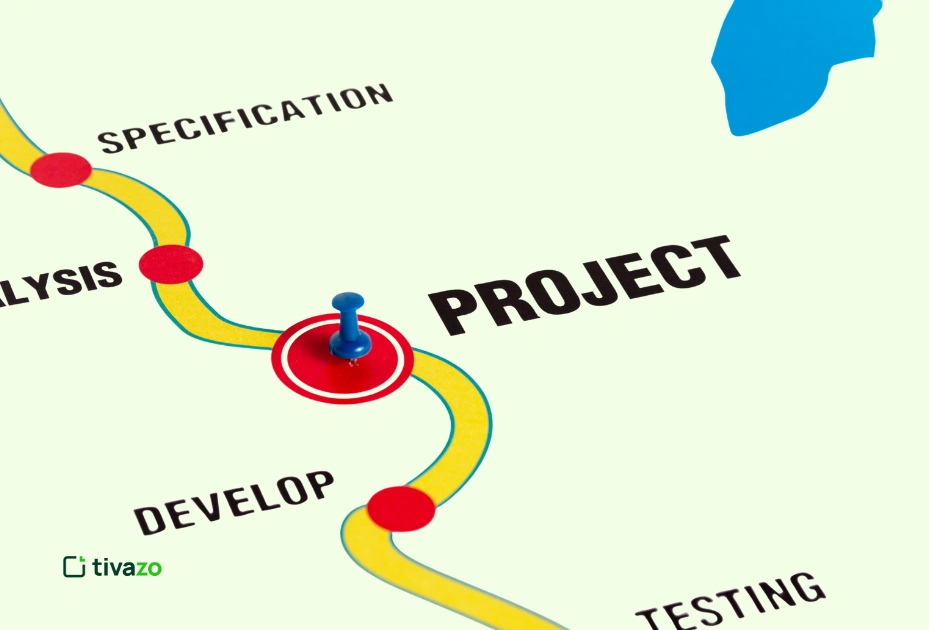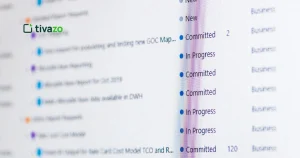A project roadmap is more than just a timeline or a list of tasks; it’s a strategic plan that guides your entire project from initiation to completion. No matter if you are a project manager, leading the team, a team lead, running the day-to-day work or stake holder interested in the high-level view, a well-crafted project roadmap allows everyone to stay aligned, engaged and focused on shared goals.
In today’s complex and fast-paced working environments, knowing how to build and leverage a project roadmap can be the difference between successful project delivery and costly blunders that frustrate all involved. A clear roadmap improves communication and coordination between team members, brings challenges into view and allows for better resource management, and helps keep the project on course.
In this blog, we are going to discuss exactly what a project roadmap is, its important role in project management, and most importantly, outline 10 actionable steps that you can take to create a project roadmap that helps you achieve success for your team and your organization.
What Is a Project Roadmap?
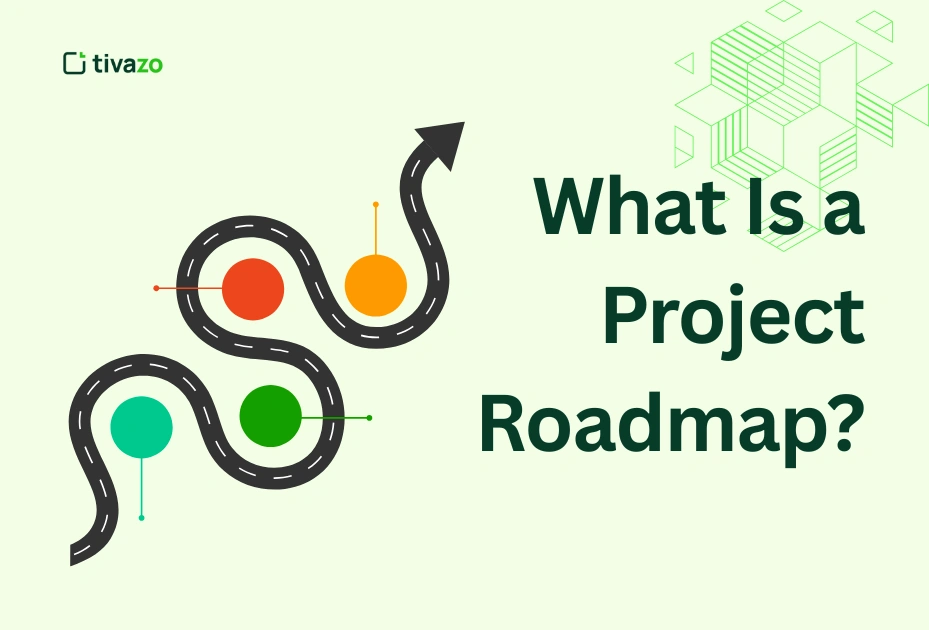
A project roadmap is a high-level visual summary that communicates key project objectives, key milestones, timing, and accountable people for the work. Think of it as the GPS for your project: it will show the destination (the final project outcome), the key stops to get there, and the best route to follow to our destination.
A project roadmap does not look at every individual day-to-day task or activity. The project roadmap instead focuses on the bigger picture. It helps the team focus on the why of the activities in the project, and the when of key events or deliverable deadlines. Understanding the big picture makes it easier to coordinate activities, communicate project details, and keep all participants aligned to the project’s direction.
Using the roadmap as a tool makes messaging clearer about what work is a priority and when it needs to happen. Therefore a good project roadmap is an important tool for your team to guide them through complexities and help them avoid confusion or misalignment.
Why a Project Roadmap Matters

A project roadmap is essential to the success of a project, as it has several purposes keeping everything in check. Here’s why creating a project roadmap is so important:
- Aligns goals across organizations: Having a project roadmap keeps everyone—whether it is marketing, sales, development, or operations—on the same page. Clear goals diminish misunderstandings and foster collaboration among teams.
- Keeps teams focused and proactive: Having a project roadmap with clear milestones and deadlines can keep teams actively thinking about what’s next. This proactive way of thinking helps eliminate last minute surprises and nothing gets rushed.
- Communicates priorities to stakeholders: A project roadmap converts details into visuals and summaries to help communicate updated themes without bombarding some one with too much information when updating an executive, or client, or other stakeholders.
- Prevents delays and scope creep: Setting very clear expectations for timelines, deliverables, and responsibilities can help to prevent a project scope from going unchecked as well as help to manage efficient timely completion of a project.
Simply put, a project roadmap acts as a guiding document benefiting clarity, coordination, and control throughout the lifecycle of a project ensuring your team stays on point, as well as the success of your project.
When to Create a Project Roadmap
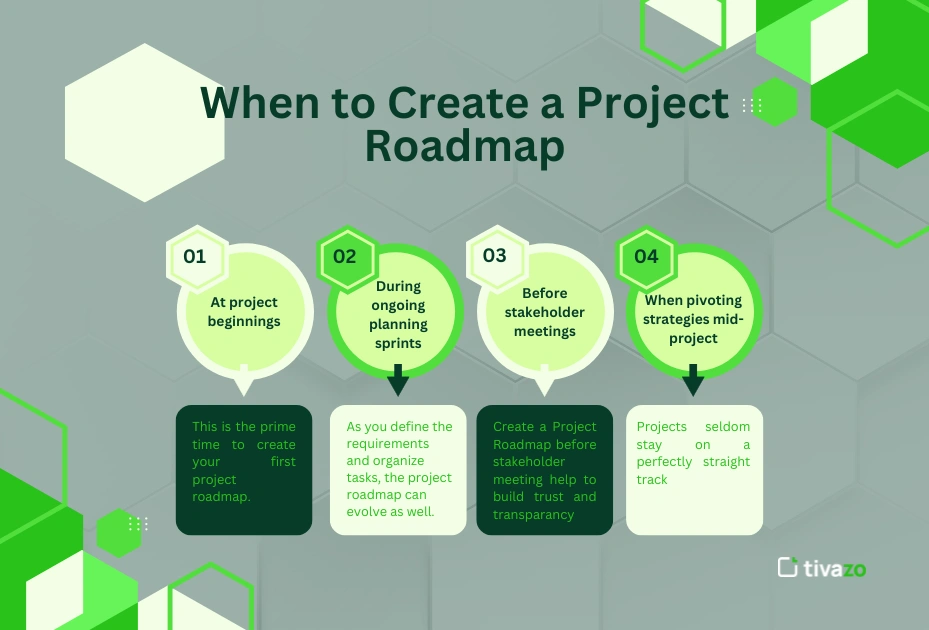
You don’t need to wait until your project officially launches to build a project roadmap. Starting to develop a roadmap early can help you save time and avoid headaches later on. Here are the best times to complete or update your project roadmap so that your project stays on target with business objectives:
- At project beginnings: This is the prime time to create your first project roadmap. Creating a project roadmap early can provide a solid starting point by defining goals, milestones, and a general roadmap for the project. Starting early helps provide focus for everyone right from the beginning.
- During ongoing planning sprints: As you define the requirements and organize tasks, the project roadmap can evolve as well. During these sprints, your project roadmap will transition into a detailed outline that will help focus your teams on priorities and dependencies.
- Before stakeholder meetings: When you, as a project manager come to a key stakeholder meeting with an up-to-date project roadmap, you can clearly show the project status, project progress, and next steps. This transparency will help build trust and have more productive discussions with executives, clients, or partners.
- When pivoting strategies mid-project: Projects seldom stay on a perfectly straight track. If/when unexpected changes or challenges happen during the course of a project, updating your project roadmap back on track and reset expectations. The project roadmap will help keep everyone coordinated. Even if there are changes in strategies, everyone can still be focused on the project.
By creating and maintaining your project roadmap at critical times such as these, you will enhance communication, understand risks, and ideally succeed at delivering your project successfully.
The 10 Powerful Steps to Build a Winning Project Roadmap
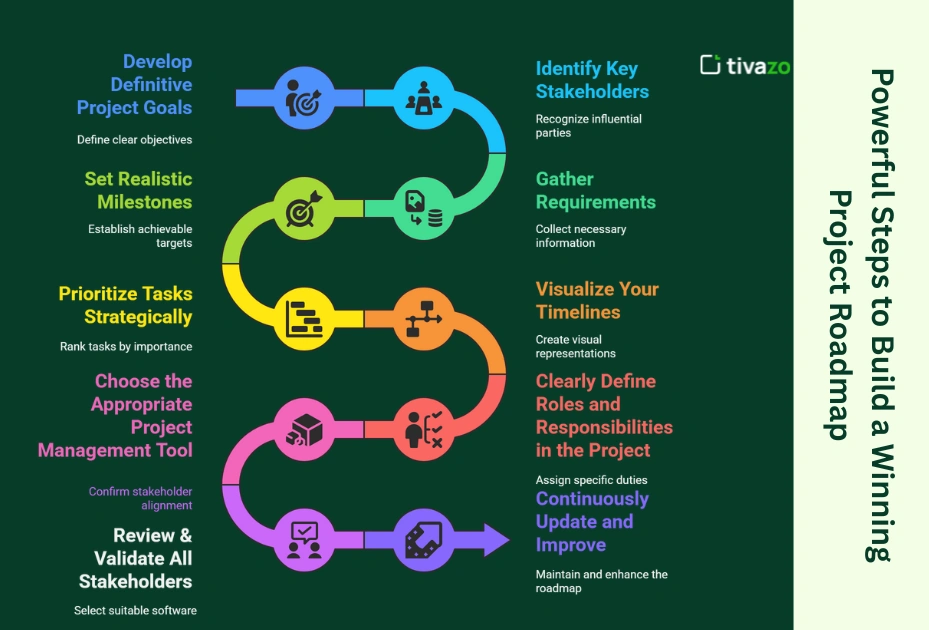
Let’s dive into the 10 key steps that will help you create a project roadmap designed for success.
1. Develop Definitive Project Goals
Identifying what your project objective is very important upfront. You can use the SMART objectives—Specific, Measurable, Achievable, Relevant, and Time-bound—to define your goals in a way which makes it easier to evaluate if they are in fact realistic and evaluatable. Definitive objectives enable to have clear direction and measurable it will help facilitate the awareness of your progress during the project. strong.
2. Identify Key Stakeholders
Identify all stakeholders with vested interest in the outcome of the project. For example, team members and clients. Understanding what each stakeholder values to realize success enables you to create roadmaps that suit their needs and gain their support for success and therefore collaboration on a shared solution.
3. Gather Requirements
Gather your scope requirements by information and input from direct engagement in the form of a survey, interviews or workshops. Ensuring the watershed of necessary scope requirements that do not miss critical details in order to mitigate possible delays or project scope workflow. The more enabled effort you use to develop your early understanding of the project, the more reliable your roadmap will be.
4. Set Realistic Milestones
Breaking your project into local milestones. Call them deliverables, but they are really just major checkpoints such as creating a prototype or finishing a phase. Make sure that your milestones are time-based and measurable. It makes it easier for the team to stay accountable, and they serve as a helpful context for what you’ve already accomplished.
5. Prioritize Tasks Strategically
Not every task is equally important. Use a prioritization methodology, like MoSCoW (Must have, Should have, Could have, Won’t have) or RICE (Reach, Impact, Confidence, Effort). Prioritize the work with the highest impact first, so that your project can advance optimally on the areas that matter most.
6. Visualize Your Timelines
Visualize your timeline using Gantt charts, timelines, or digital project management tools. Visual timelines make it easier for anyone to see dates of when tasks start and end, what tasks rely on what other tasks to finish, and how to manage deadlines.
7. Clearly Define Roles and Responsibilities in the Project
Define which team member is responsible for which task. This is easier said than done; if you’re up for it, there are lots of tools you can use to help, like a RACI chart (Responsible, Accountable, Consulted, Informed). This kind of clarity avoids confusion, and ensures that every task has an owner, which helps with accountability within the team.
8. Choose the Appropriate Project Management Tool
Select a tool that suits your team’s workflows and project needs. Jira, or Asana are popular project management tools with helpful features for building a roadmap, collaborating, and tracking progress. Once you have selected the tool that works best for your team and project, you can streamline the process and optimize communication.
9. Review & Validate All Stakeholders
Before finalizing your roadmap, it’s essential to check in with your stakeholders. Share with them and ask for feedback. This review process is helpful to identify gaps, timelines that are unrealistic, or other misunderstandings. The feedback you collect is valuable, and can help you address problems with your plan before you finalize it.
10. Continuously Update and Improve
Treat your project roadmap like a “living document.” The roadmap should be updated regularly after any sprint reviews, changes in scope, and shifts in priority. Continual improvement is crucial for ensuring your roadmap stays current and relevant to you and your team throughout the project execution.
Common Mistakes to Avoid in a Project Roadmap
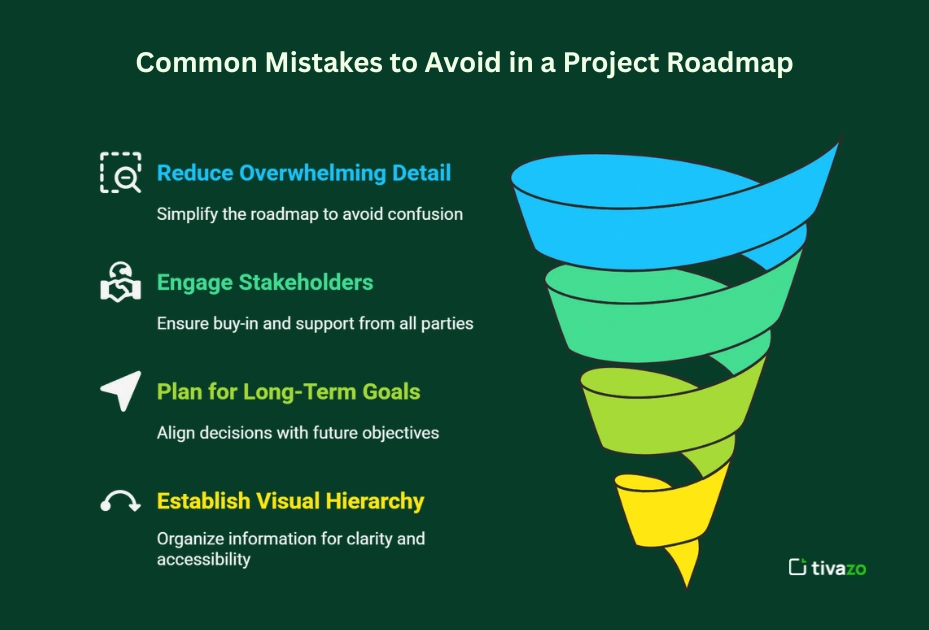
It’s important to consider what kinds of traps can weaken the overall effectiveness of a project roadmap so you can avoid making those same pitfalls:
- Overwhelming detail: It is important to keep the project roadmap brief and focused. Adding too much detail results in a project roadmap that can be overwhelming for both your internal team and stakeholders.
- Ignoring stakeholders: Stakeholders input is crucial; if you don’t get this, the project roadmap may miss the details and priorities that matter most, resulting in misalignment.
- Planning for the moment: A project roadmap should evolve as the project progresses. If you fail to update it regularly, you will fall behind and the usefulness of a project roadmap grows thinner when it is static.
- Visual hierarchy: Don’t underestimate the importance of visuals such as format, colour, size, etc to prioritise important milestones on the deliverables. If the project roadmap lacks visual hierarchy it is easy to miss the information that should be most important, because the overall product can seem overwhelming or plain.
By avoiding these project roadmap traps, you can help ensure that your project roadmap remains clear, relevant, and effective throughout the project.
Best Tools to Create a Project Roadmap
Finding the perfect tool to create and manage your project roadmap can be a huge benefit to how you plan; communicate; and monitor progress. Here are a few of the best tools that have solid roadmap functionality:
- Asana: Easy to use, robust and multipurpose; Asana has project view, timeline, and roadmap views. Asana supports task dependencies, integrates with many apps, and is great to complete your project roadmap.
- Jira: A good fit for agile teams, since Jira works best for backlog and sprint management. Jira also has roadmap features so you can track your releases and dependencies to stay aligned with your project goals.
- Trello: Trello is simple, effective, and user friendly; using Trello’s card structure will work very well for small projects or teams new to roadmaps. Trello’s drag-and-drop functionality is ideal to manage milestones.
- Monday.com: Monday.com has easy to customize dashboards, automations, and improves collaboration; its roadmaps view helps teams maintain schedules and manage who is responsible for work.
Each of these tools has unique strengths; select what works for your team size and project needs.
Tips for Presenting Your Project Roadmap to Stakeholders
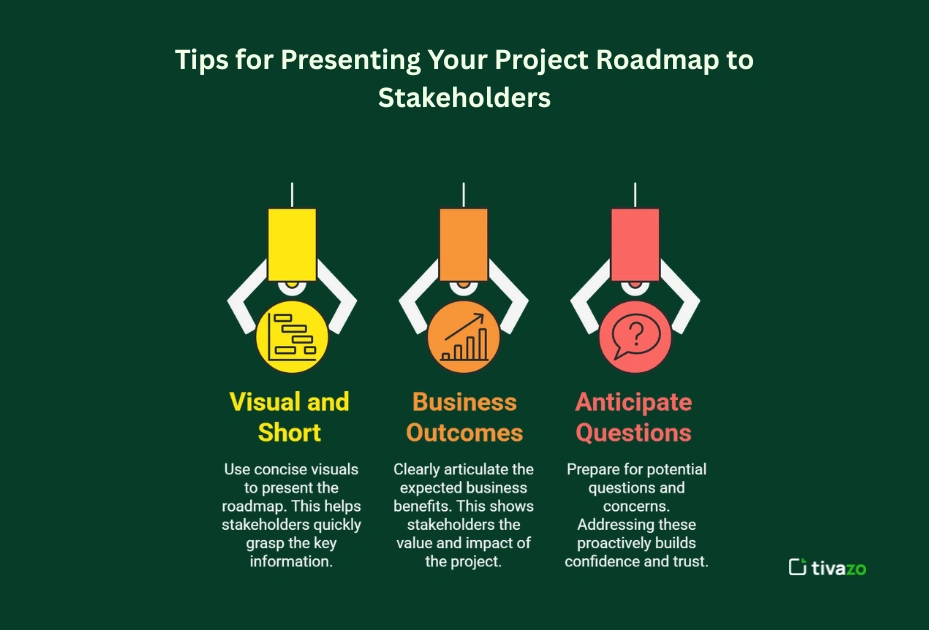
When it comes time to communicate your project roadmap to your stakeholders, you want to communicate effectively, build trust, and ensure everyone is on the same page with the direction of the project. Here are some tips to keep in mind that will assist you with presenting your roadmap:
- Keep it visual and short: Present information with visuals such as charts, timelines, and bullet points to support comprehension and digestion. A simple, well-designed project roadmap, is better than a slide filled with text.
- Demonstrate the business outcomes: Stakeholders want to know what impacts the project will have. Show the stakeholders how your roadmap gets you closer to their strategic goals and demonstrates value for money to support the overall business objectives.
- Anticipate objections or questions: Be prepared to explain your decisions – particularly around timelines, resources, and priorities – to address concerns upfront, indicate preparation, and build credibility.
A confident, well-prepared presentation builds trust, promotes collaboration and improves the likelihood of complete stakeholder buy-in for your project roadmap.
Project Roadmap vs. Product Roadmap
Though related, these two are different:
| Aspect | Project Roadmap | Product Roadmap |
|---|---|---|
| Focus | Delivery of a specific project | Product development and lifecycle |
| Timeline | Defined start and end dates | Ongoing and evolving |
| Audience | Project team, stakeholders | Product managers, customers |
| Key Components | Milestones, tasks, timelines | Features, releases, user needs |
Understanding the difference helps you use the right roadmap for your needs.
Final Thoughts: Roadmapping for Long-Term Project Success
A project roadmap is your ally in efficiently managing successful projects. It provides structure, connects the teams, and help everyone navigate in the same direction. By following these 10 impactful steps, you create clarity and allow room for smoother execution and results.
A project roadmap is also not a one-time document–it is a living guide. A project road map will constantly grow and change as your project does. Regular updates and revisions will keep its relevancy, and keep you and your team aligned as goals evolve.
Start building your project roadmap today and take a step forward in project management and ensuring long-term success.
FAQs:
What is in a project roadmap?
A project roadmap typically includes high-level details such as project objectives, key milestones, timelines, deliverables, and assigned responsibilities. It provides a strategic overview rather than granular task lists, helping teams and stakeholders stay aligned throughout the project lifecycle.
What are the 5 stages of a project?
The five main stages of a project are:
- Initiation: Defining the project’s purpose, goals, and feasibility
- Planning: Creating a project roadmap, setting milestones, and assigning tasks
- Execution: Carrying out the planned tasks and deliverables
- Monitoring & Controlling: Tracking progress, managing changes, and staying on schedule
- Closure: Finalizing deliverables, evaluating results, and closing the project officially.
Each stage benefits from a clear project roadmap to ensure proper direction and communication.
How do I create a roadmap?
To create a project roadmap, follow these steps:
- Define clear project objectives
- Identify key stakeholders
- Gather requirements and resources
- Break down tasks into milestones
- Assign responsibilities
- Map out timelines visually
- Use a project management tool
- Review with stakeholders and update regularly
This strategic approach ensures your roadmap serves as a reliable guide throughout your project.
What are the 7 steps of project planning?
The seven essential steps of project planning are:
- Define project goals and scope
Identify stakeholders and roles
Break the project into tasks
Develop a project roadmap with milestones
Estimate resources and timelines
Assess risks and prepare mitigation plans
Finalize and communicate the plan to all team members
These steps help create a structured foundation for successful project execution.
